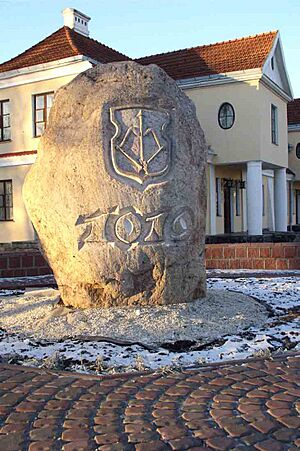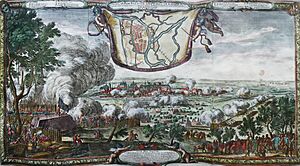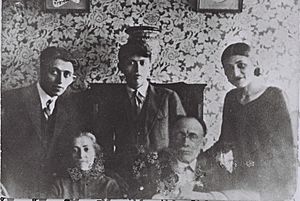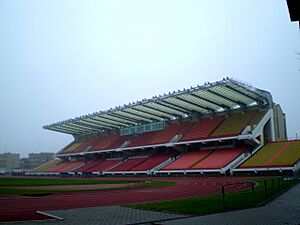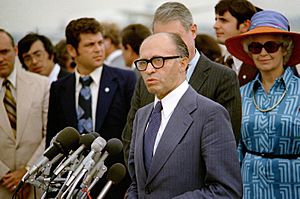Brest, Belarus facts for kids
Quick facts for kids
Brest
|
|||
|---|---|---|---|

|
|||
|
|||
| Country | Belarus | ||
| Region | Brest Region | ||
| First mentioned | 1017 | ||
| Area | |||
| • Total | 145 km2 (56 sq mi) | ||
| Elevation | 280.4 m (919.9 ft) | ||
| Population
(2024)
|
|||
| • Total | 344,470 | ||
| • Density | 2,376/km2 (6,153/sq mi) | ||
| Time zone | UTC+3 (MSK) | ||
| Postal code |
224000
|
||
| Area code(s) | +375 (0)162 | ||
| License plate | 1 | ||
| Website | City executive committee's official website: https://city-brest.gov.by/en/ | ||
Brest is a city in Belarus, a country in Eastern Europe. It sits right on the border with Poland, where the Bug and Mukhavets rivers meet. This makes Brest an important border town.
Brest is the main city of the Brest Region in Belarus. As of 2024, about 344,470 people live there.
This city is one of the oldest in Belarus and has a long history. Many important events happened here, like the Union of Brest and the Treaty of Brest-Litovsk. The Brest Fortress is also famous. It was honored as a "Hero Fortress" by the Soviet Union for its brave defense in June 1941 during World War II.
Over the centuries, Brest was part of different countries. It was often controlled by Poland, parts of ancient Russia (called Kievan Rus'), and the Grand Duchy of Lithuania. From the late Middle Ages until 1795, it was part of the Grand Duchy of Lithuania, which later joined with Poland to form the Polish–Lithuanian Commonwealth.
In 1795, Brest became part of the Russian Empire. After the Polish-Soviet War, it was part of Poland again. In 1939, during World War II, it was taken by Nazi Germany and then given to the Soviet Union. The Germans took it back in 1941 but the Soviet Red Army recaptured it in 1944. Brest was part of the Byelorussian Soviet Socialist Republic until the Soviet Union broke up in 1991. Since then, Brest has been part of independent Belarus.
Contents
- What's in a Name? The Story of Brest
- Brest Through the Ages: A City's Journey
- Brest's Location and Environment
- Brest's Weather
- Cool Places to Visit in Brest
- Learning in Brest
- Getting Around Brest
- Sports in Brest
- Brest in the News
- Brest's International Friends
- Special Recognition
- Famous People from Brest
- Images for kids
- See also
What's in a Name? The Story of Brest
The name "Brest" has a few possible origins. One idea is that it comes from a Slavic word, berest, which means 'elm tree'. Another theory suggests it comes from the Lithuanian word brasta, meaning 'ford' or a shallow place in a river where you can cross.
In the past, Belarusian speakers called the city Bieraście. The Ukrainian name is Berestia.
Brest was once a center for Jewish learning. In the Yiddish language, it was called Brisk. This is why followers of the important Soloveitchik family of rabbis are sometimes called "Brisker."
Brest joined the Grand Duchy of Lithuania in 1319. When the Polish–Lithuanian Commonwealth was formed in 1569, the city became known in Polish as Brześć. It was also called Brześć Litewski, meaning "Lithuanian Brest," to tell it apart from another city named Brześć.
In 1795, when it became part of the Russian Empire, it was called Brest-Litovsk or "Lithuanian Brest." After World War I, in 1923, Poland renamed it Brześć nad Bugiem, meaning "Brest on the Bug River." After World War II, when it became part of the Byelorussian Soviet Socialist Republic, its name was simply "Brest."
Brest has its own special symbol, a coat of arms, which was adopted in 1991. It shows a silver arrow pointing up and a silver bow on a blue shield. Sometimes, it's shown with a red shield instead. The first coat of arms for Brest was given by King Sigismund II Augustus in 1554.
Brest Through the Ages: A City's Journey
Brest, then called Berestij, was first mentioned in old writings in 1019. This was when the Kievan Rus' took the stronghold from the Poles. It is one of the oldest cities in Belarus. For a long time, Polish rulers and princes from Kievan Rus' fought over it.
The city was destroyed by the Mongols in 1241. It was rebuilt around 1275. Around the 1270s, the Grand Duchy of Lithuania and the Kingdom of Galicia–Volhynia also fought for control of the city.
Becoming Part of Lithuania
In 1319, Brest became part of the Grand Duchy of Lithuania. In 1390, Brest was the first city in what is now Belarus to get Magdeburg rights. These rights allowed cities to govern themselves and set up their own courts.
In 1409, important leaders like King Władysław II Jagiełło and Grand Duke Vytautas the Great met in Brest. They planned for a war against the Teutonic Order. The next year, Brest sent a group of cavalry (soldiers on horseback) to help win the Battle of Grunwald.
The city grew a lot under these leaders. In 1440, a special meeting of the Grand Duchy of Lithuania was held in Brest. Here, Casimir IV Jagiellon was chosen as the Grand Duke.
Under the Polish–Lithuanian Commonwealth
![]() Principality of Galicia–Volhynia (1240–1246)
Principality of Galicia–Volhynia (1240–1246)
![]() Mongol Empire (1246–1319)
Mongol Empire (1246–1319)
![]() Grand Duchy of Lithuania (1319–1320)
Grand Duchy of Lithuania (1319–1320)
![]() Kingdom of Galicia–Volhynia (1320–1321)
Kingdom of Galicia–Volhynia (1320–1321)
![]() Grand Duchy of Lithuania (1321–1349)
Grand Duchy of Lithuania (1321–1349)
![]() Kingdom of Poland (1349–1351)
Kingdom of Poland (1349–1351)
![]() Grand Duchy of Lithuania (1351–1569)
Grand Duchy of Lithuania (1351–1569)
![]() Polish–Lithuanian Commonwealth (1569–1795)
Polish–Lithuanian Commonwealth (1569–1795)
![]() Russian Empire (1795–1812)
Russian Empire (1795–1812)
![]() French occupation (1812)
French occupation (1812)
![]() Russian Empire (1812–1915)
Russian Empire (1812–1915)
![]() German occupation (1915–1918)
German occupation (1915–1918)
![]() Second Polish Republic (1918–1919)
Second Polish Republic (1918–1919)
![]() SSR Byelorussia (1919)
SSR Byelorussia (1919)
![]() Second Polish Republic (1919–1939)
Second Polish Republic (1919–1939)
![]() Soviet occupation (1939–1941)
Soviet occupation (1939–1941)
![]() German occupation (1941–1944)
German occupation (1941–1944)
![]() Soviet occupation (1944–1945)
Soviet occupation (1944–1945)
![]() Soviet Union (1945–1991)
Soviet Union (1945–1991)
![]() Belarus (1991–present)
Belarus (1991–present)
In 1500, the city was burned by Crimean Tatars. In 1566, a new region called the Brest Litovsk Voivodeship was created.
Brest was an important meeting place. In 1594 and 1596, important church meetings were held there. The 1596 meeting led to the creation of the Uniate Church, which combined some traditions of the Eastern Orthodox Church with the Roman-Catholic Church.
In 1657 and 1706, the Swedish army captured the town and its castle during their invasions. In 1660, the Russian army also attacked. They took the Brest Castle and many defenders and their families were killed.
Brest Becomes Part of Russia
In 1794, a battle took place near Brest where Russian forces defeated a Polish-Lithuanian division. After this, Brest became part of Russia in 1795. This happened during the Third Partition of Poland, when Poland and Lithuania were divided up by neighboring countries.
From the 1800s to World War I
During the 1800s, the Brest Fortress was built in and around the city by the Russians. They tore down the old Polish Royal Castle and much of the old town to make space for the fortress. In 1895, a huge fire left 15,000 people without homes and many people died.

During World War I, the German army captured Brest in August 1915. In March 1918, a very important agreement, the Treaty of Brest-Litovsk, was signed in the Brest Fortress. This treaty ended the war between Soviet Russia and the Central Powers.
Brest in Poland Between the World Wars
In February 1919, Polish troops entered the city, and Brest became part of Poland again. Its borders were officially set by the Treaty of Riga in 1921. In 1923, the city was renamed Brześć nad Bugiem (Brest on the Bug).
The city grew a lot during this time. Many new public buildings were built. These included the Bank of Poland and other government offices. New housing areas were also built, including one for Jewish people who had lost their homes in World War I.
Many new schools were opened, including Jewish schools where Yiddish and Hebrew were taught. In 1936, Jewish people made up a large part of Brest's population.
World War II and Its Impact
In September 1939, during the German Invasion of Poland, a small Polish army group bravely defended Brest. After four days of heavy fighting, they had to leave. On the same day, the Soviet army also entered the city. A joint parade of German and Soviet soldiers took place in Brest on September 22, 1939.
During the time the Soviets controlled the city (1939-1941), many Polish people were arrested and sent to distant places like Siberia. It is thought that some were killed by the Soviets.

On June 22, 1941, Nazi Germany attacked Brest Fortress and the city. This was the first day of their invasion of the Soviet Union. The fortress defenders fought for six days, and almost all of them died. The Germans then took control of Brest.
The Jewish community in Brest, about 20,000 people, was forced into a special area called the Brest ghetto in December 1941. Sadly, in October 1942, almost all of them were killed. Only a very small number of Jewish people survived these terrible events.
The Germans also ran prisons and forced labor camps in the city. The Polish resistance was active in Brest during this time.
The Soviet Red Army recaptured the city on July 28, 1944. The following year, Brest officially became part of the Soviet Union.
After the War
After the war, a Polish resistance group called the "Freedom Defenders Association" was formed in Brest. They secretly taught Polish history and helped people who were in trouble. However, this group was stopped by the Soviet secret police in 1948, and its members were sent to forced labor camps.
In 2019, a large grave was found in the old Brest Ghetto area. It contained the remains of over 1,200 people, most of whom are believed to be Jewish victims of the Nazis.
Brest's Location and Environment
Brest is located on the Mukhavets River. This river flows west through the city, dividing it into northern and southern parts. It then meets the Bug River inside the Brest Fortress. The river flows slowly, and in Brest, it looks quite wide.
The land around Brest is mostly flat. In the past, the city experienced floods. One of the worst floods happened in 1974.
East of Brest, the Dnieper–Bug Canal was built in the mid-1800s. This canal connects the Mukhavets River to the Pina River, which flows into the Pripyat River, and then into the Dnieper River. This means Brest has a water route all the way to the Black Sea.
Brest's Weather
Brest has a humid continental climate. This means it has warm summers and cold winters. Winter temperatures often hover around freezing, but summers are warm because the city is far from the sea.
| Climate data for Brest (1991–2020, extremes 1888–present) | |||||||||||||
|---|---|---|---|---|---|---|---|---|---|---|---|---|---|
| Month | Jan | Feb | Mar | Apr | May | Jun | Jul | Aug | Sep | Oct | Nov | Dec | Year |
| Record high °C (°F) | 15.9 (60.6) |
17.2 (63.0) |
24.7 (76.5) |
30.7 (87.3) |
32.1 (89.8) |
34.3 (93.7) |
36.6 (97.9) |
36.7 (98.1) |
34.4 (93.9) |
26.4 (79.5) |
19.0 (66.2) |
14.5 (58.1) |
36.7 (98.1) |
| Mean daily maximum °C (°F) | 0.0 (32.0) |
1.7 (35.1) |
7.0 (44.6) |
14.4 (57.9) |
20.2 (68.4) |
23.5 (74.3) |
25.6 (78.1) |
25.0 (77.0) |
19.2 (66.6) |
12.6 (54.7) |
6.0 (42.8) |
1.4 (34.5) |
13.1 (55.6) |
| Daily mean °C (°F) | −2.3 (27.9) |
−1.2 (29.8) |
2.7 (36.9) |
9.2 (48.6) |
14.5 (58.1) |
18.0 (64.4) |
19.9 (67.8) |
19.2 (66.6) |
13.9 (57.0) |
8.4 (47.1) |
3.4 (38.1) |
−0.8 (30.6) |
8.7 (47.7) |
| Mean daily minimum °C (°F) | −4.5 (23.9) |
−3.8 (25.2) |
−0.8 (30.6) |
4.3 (39.7) |
9.1 (48.4) |
12.6 (54.7) |
14.7 (58.5) |
13.9 (57.0) |
9.4 (48.9) |
5.0 (41.0) |
1.2 (34.2) |
−2.9 (26.8) |
4.9 (40.8) |
| Record low °C (°F) | −35.5 (−31.9) |
−28.1 (−18.6) |
−22.6 (−8.7) |
−6.2 (20.8) |
−4.2 (24.4) |
2.1 (35.8) |
5.8 (42.4) |
1.3 (34.3) |
−2.8 (27.0) |
−9.9 (14.2) |
−19.2 (−2.6) |
−25.1 (−13.2) |
−35.5 (−31.9) |
| Average precipitation mm (inches) | 36 (1.4) |
35 (1.4) |
33 (1.3) |
39 (1.5) |
67 (2.6) |
68 (2.7) |
83 (3.3) |
62 (2.4) |
56 (2.2) |
42 (1.7) |
39 (1.5) |
40 (1.6) |
600 (23.6) |
| Average extreme snow depth cm (inches) | 6 (2.4) |
7 (2.8) |
3 (1.2) |
0 (0) |
0 (0) |
0 (0) |
0 (0) |
0 (0) |
0 (0) |
0 (0) |
1 (0.4) |
4 (1.6) |
7 (2.8) |
| Average rainy days | 11 | 9 | 12 | 12 | 16 | 16 | 16 | 12 | 15 | 14 | 14 | 13 | 160 |
| Average snowy days | 16 | 16 | 10 | 3 | 0.1 | 0 | 0 | 0 | 0 | 1 | 7 | 14 | 67 |
| Average relative humidity (%) | 85 | 82 | 75 | 66 | 66 | 69 | 70 | 71 | 78 | 81 | 86 | 87 | 76 |
| Mean monthly sunshine hours | 43.3 | 64.6 | 139.4 | 198.6 | 267.9 | 282.1 | 284.7 | 268.0 | 182.4 | 119.6 | 49.1 | 35.8 | 1,935.5 |
| Percent possible sunshine | 19 | 25 | 36 | 42 | 51 | 52 | 52 | 54 | 45 | 36 | 18 | 14 | 41 |
| Source 1: Pogoda.ru.net | |||||||||||||
| Source 2: NOAA, Belarus Department of Hydrometeorology (percent sun from 1949–1951 and 1953–2000) | |||||||||||||
Cool Places to Visit in Brest
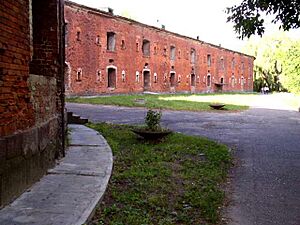
One of the most important places to visit is the huge Soviet-era war memorial at the Brest Fortress. It honors the brave defenders of the fortress from the 1941 battle. You can also visit the Berestye Archeological Museum to see parts of the old city from the 11th to 13th centuries.
The Museum of Rescued Art Treasures has a collection of beautiful paintings and religious art. Brest City Park is over 100 years old and is a great place to relax. In 2009, the Millennium Monument of Brest was built. Sovetskaya Street is a popular street in Brest with shops and cafes. Another interesting place is the Brest Railway Museum.
Learning in Brest
Brest has two universities: A.S. Pushkin Brest State University and Brest State Technical University. There are also many colleges for different subjects, like:
- Brest State Railway College
- Brest State Medical College
- Brest State Musical College
- Brest State Regional College of the Olympic Reserve
- Brest State Polytechnic College
- Brest State Professional-Technical College of Instrument Engineering
- Brest State College of Transport and Service
- Brest State College of Light Industry
- Brest State College of Builders
- Brest State College of Communications
- Brest State College of Service Industry
Getting Around Brest
Brest is a very important transport hub. It's on the main railway line that connects Berlin and Moscow. It's also on a major highway that goes across Europe. This makes Brest a key crossing point between the European Union and the Commonwealth of Independent States.
The city has the Brest-Tsentralny railway station. Because the railway tracks change width here (from European standard to Russian broad gauge), trains from Poland have to change their wheels. Freight (goods) also needs to be moved from one type of train car to another.
Brest also has a local airport, Brest Airport (code BQT). It has seasonal flights to places like Kaliningrad and charter flights to holiday spots like Burgas and Antalya.
Sports in Brest
HC Meshkov Brest is a very successful handball team for men in Belarus. There's also a women's handball team called HC Victoria-Berestie.
If you like ice hockey, HK Brest is the local professional team. Football is also popular, with the local club FC Dynamo Brest playing in the top league.
Brest has great sports facilities, including an indoor track-and-field center, an ice rink, and Belarus's first outdoor baseball stadium. There's also a large rowing course that can host international competitions.
Brest in the News
Brest has several local newspapers, including Brestskaya Gazeta, Brestskiy Kurier, and Vecherniy Brest.
Brest's International Friends
Brest has many "sister cities" around the world. These are cities that have special friendly relationships and often work together on projects.
Sister cities
 Astrakhan, Russia
Astrakhan, Russia Dorogomilovo District (Moscow), Russia
Dorogomilovo District (Moscow), Russia Izhevsk, Russia
Izhevsk, Russia Kaliningrad, Russia
Kaliningrad, Russia Kovrov, Russia
Kovrov, Russia Malgobek, Russia
Malgobek, Russia Nevsky District (Saint Petersburg), Russia
Nevsky District (Saint Petersburg), Russia Nizhny Tagil, Russia
Nizhny Tagil, Russia Novorossiysk, Russia
Novorossiysk, Russia Oryol, Russia
Oryol, Russia Petrozavodsk, Russia
Petrozavodsk, Russia Ryazan, Russia
Ryazan, Russia Tyumen, Russia
Tyumen, Russia Ivano-Frankivsk, Ukraine
Ivano-Frankivsk, Ukraine Lutsk, Ukraine
Lutsk, Ukraine Odesa, Ukraine
Odesa, Ukraine Siedlce County, Poland
Siedlce County, Poland Terespol, Poland
Terespol, Poland Baienfurt, Germany
Baienfurt, Germany Baindt, Germany
Baindt, Germany Berg, Germany
Berg, Germany Ravensburg, Germany
Ravensburg, Germany Weingarten, Germany
Weingarten, Germany Baiyin, China
Baiyin, China Xiaogan, China
Xiaogan, China Batumi, Georgia
Batumi, Georgia Nakhchivan, Azerbaijan
Nakhchivan, Azerbaijan Coevorden, Netherlands
Coevorden, Netherlands Port-sur-Saône, France
Port-sur-Saône, France Subotica, Serbia
Subotica, Serbia
One former sister city was Biała Podlaska in Poland. However, in March 2022, this partnership was paused because of Belarus's involvement in the conflict in Ukraine.
Other forms of cooperation
Brest also works with other cities, including:
Special Recognition
A small planet, called 3232 Brest, was discovered in 1974 and named after the city.
Famous People from Brest
Many notable people have come from Brest, including:
- Menachem Begin, who later became the Prime Minister of Israel.
- Jarosław Dąbrowski, a Polish revolutionary and general.
- David Dubinsky, a leader of a large workers' union in America.
- Yulia Nesterenko, an Olympic champion in the women's 100-meter race.
- David B. Steinman, an American engineer who designed famous bridges, like the Mackinac Bridge.
- Ganna Walska, a Polish opera singer.
- Liubov Charkashyna, a Belarusian Olympic medalist in rhythmic gymnastics.
Images for kids
See also
 In Spanish: Brest (Bielorrusia) para niños
In Spanish: Brest (Bielorrusia) para niños





